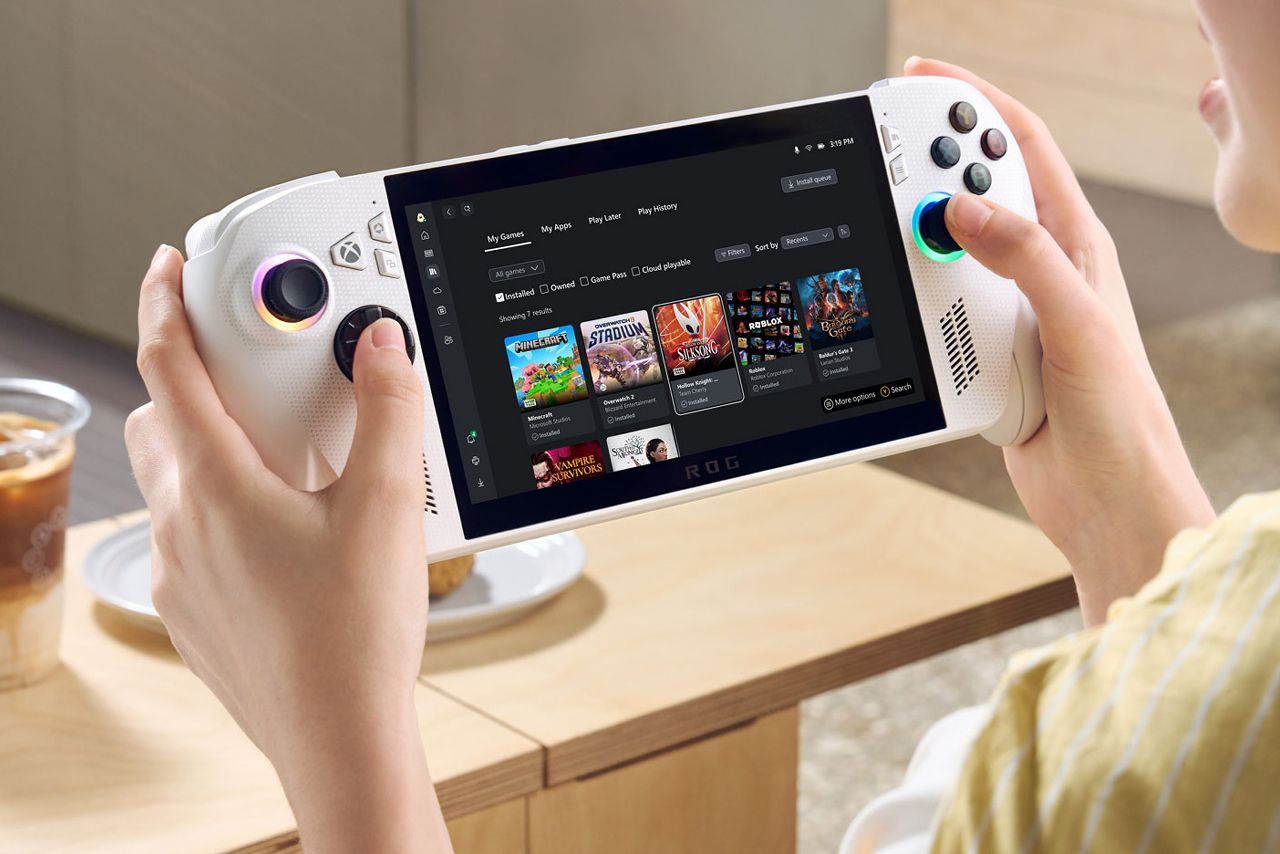
Portable PC Gaming: Rise of Handhelds, from Asus to Valve & Microsoft
|
|
Portable PC gaming has seen a major surge: after the Steam Deck launched in 2022, the idea of a pocket-sized gaming PC quickly moved from a niche concept to the mainstream. Riding on that momentum, Asus introduced its own handheld. In 2023, the company unveiled the Asus ROG Ally, a full-featured handheld PC running Windows 11, equipped with an AMD Ryzen Z1 Extreme and a 120 Hz display, priced similarly to an entry-level gaming laptop.
And now (June 8, 2025), at the Xbox Games Showcase, Microsoft and Asus announced the launch of the first Xbox-branded handheld PCs: the ROG Xbox Ally and the higher-end ROG Xbox Ally X. Both run Windows 11 and play native Xbox and PC titles, but the Ally uses an AMD Ryzen Z2 A with 16 GB of RAM and a 512 GB SSD, while the Ally X upgrades to a Ryzen AI Z2 Extreme, 24 GB of RAM, and a 1 TB SSD.
Introduction: Long Road to Handheld PC Gaming
First ROG Ally looked revolutionary, yet its 2023 debut is merely the latest step in Windows devices’ long evolution: from pocket PCs running Windows CE in the nineties, through the experimental Origami and UMPC projects of the mid-noughties, to Chinese GPD Win and AYA Neo, and finally the Valve’s Steam Deck, which proved the viability of the form factor.
The purpose of this article is to follow that path step by step: how Microsoft laid the groundwork back in 2006, and how Valve and Asus has since refined the idea of a handheld PC into a capable tool for playing modern AAA games. We’ll look at the key milestones, technical challenges, and why portable PC gaming is on its way to becoming the new standard.

Origins of Windows Handhelds
In the mid-1990s, Microsoft considered bringing the desktop Windows experience to a pocket-sized electronic diary. The result was Windows CE 1.0, released in November 1996. Based on it, the first Handheld PCs arrived (the HP 300LX, NEC MobilePro 400, and Philips Velo 1). Each weighed under 500 grams, ran on AA batteries, and offered a QWERTY keyboard beneath a monochrome 640×240 screen. They could sync email via an infrared port, open Word and Excel files, and, most importantly, they used a stripped-down yet familiar Win32 API.
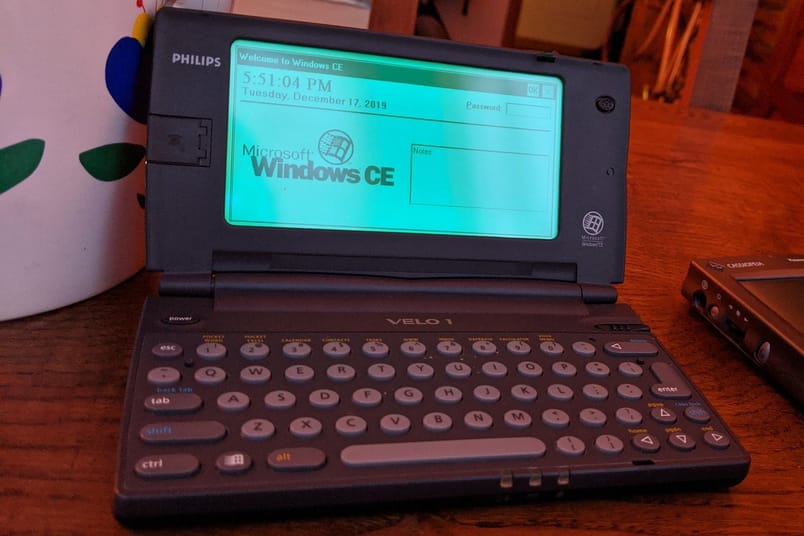
By decade’s end, the form factor had evolved into touchscreen PDAs without hardware keyboards. The Compaq iPAQ 36xx, HP Jornada 560, and Casio Cassiopeia E-125 featured 206 MHz StrongARM chips, 3.8-inch color TFT screens, and CompactFlash slots for Wi-Fi cards. They could run Doom, Quake (at 10-15 FPS), and NES emulators, but the small displays, stylus controls, and modest batteries made serious gaming more of a tech showcase than a practical option. These devices were never designed with gaming in mind.
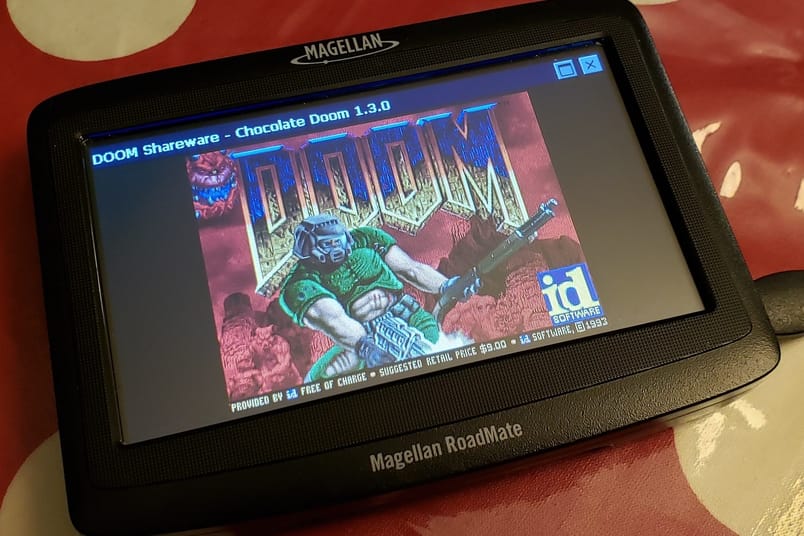
UMPC: Handheld PC Ahead of Time
By 2004, laptops already weighed roughly two kilograms, yet Microsoft and Intel still spotted a niche for something even more mobile. In March 2006, at CeBIT (computer expo, now defunct), they unveiled the Ultra-Mobile PC (UMPC) initiative, codenamed Origami, built around a 7-inch touchscreen, Windows XP Tablet PC Edition, two to four hours of battery life, and a price of about $1,000.
Early models included the Samsung Q1, Sony VAIO UX180P, and Asus R2H. The R2H packed a 900 MHz Celeron M, 512 MB RAM, a 60 GB HDD, GPS, Bluetooth, and Wi-Fi; it weighed 830 grams and cost of $999. Trade-offs (a noisy active cooling system, roughly two-hour battery life, and laptop-level pricing) kept it from mass appeal. Half-Life, for instance, could run at low resolution, but the line targeted business users, not gamers, anyway.
Even so, UMPCs solved a key engineering problem: fitting an x86 processor and full Windows into a sub-ten-inch chassis. They proved the form factor’s viability and paved the way for later Windows handhelds, from GPD Win to the Asus ROG Ally.
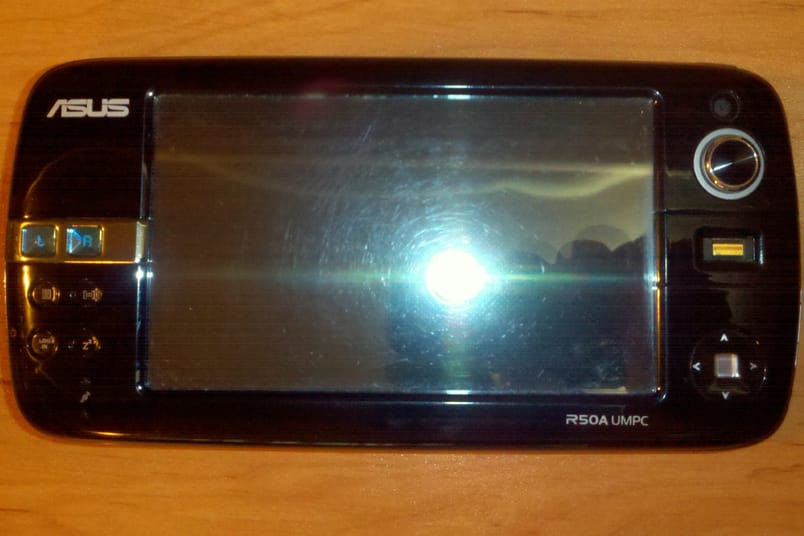
Indie Boom of Pocket PC Gaming: GPD, AYA, and OneXPlayer
After the UMPC era, the market collapsed: iOS and Android tablets covered day-to-day needs, and ultrabooks became light enough to carry around. Manufacturers shuttered their product lines, and Windows handhelds slipped underground. After a lull in the late 2000s, the Windows-handheld scene was reborn on crowdfunding platforms.
In October 2016, China’s GamePad Digital raised more than $720,000 for the GPD Win: a 5.5-inch laptop-console with keyboard, gamepad, and Atom x7-Z8700 running Windows 10 Home. For $350, it offered 4 GB of RAM, 64 GB of eMMC storage, a 6,900 mAh battery, and could run Skyrim or Dark Souls at 720p with 30 FPS. The crowdfunding success served as proof of concept that handheld PC gaming had a real audience even without a big brand.
Indie hardware grows up: OneXPlayer and AYA
It sparked follow-up models (Win 2, 3, 4) and rivals. Also, the 2017 release of the Nintendo Switch spurred manufacturers to look for possible solutions (obviously, not a PC handheld, but similar niche). In May 2021, One Netbook launched OneXPlayer on Indiegogo: an 8.4-inch IPS 2560×1600 screen, Intel Core i7-1165G7, a 60 Wh battery, and a starting price of $819, a desktop-level performance (on par with Tiger Lake) in a portable handheld.
Meanwhile, in March 2021, the startup AYA introduced the AYA Neo 2021 with a Ryzen 5 4500U (six cores, Vega 6) and a 7-inch IPS 1280×800 panel; the Pro model moved to a Ryzen 7 4800U. Prices started at $899, with up to 32 GB of LPDDR4X and NVMe SSD support, delivering two to three times the FPS of first-wave Atom devices.
Shipments were small, yet GPD, OneXPlayer, and AYA Neo built an active community, filled YouTube with reviews, drew in developers (WOA, Handheld Companion), and showed that Windows gaming on the go is no longer a curiosity, but a growing segment poised for a major breakthrough.

Steam Deck: How Valve Sparked New Age of Handheld PCs
In July 2021, Valve announced the Steam Deck (not to be confused with Steam Machine), and first deliveries began on 25 February 2022. The device’s AMD Van Gogh APU (4-core Zen 2 @ 3.5 GHz with 8 RDNA 2 CUs) is paired with 16 GB of LPDDR5, with pricing starting at $399. Instead of Windows, Valve shipped SteamOS 3 (saving a lot of performance due to the absence of bloatware), a Linux-based system whose Proton layer runs most Windows games with minimal setup. A 7-inch 1280×800 widescreen display, solid ergonomics, and an aggressively low price pushed the handheld PC into the mainstream.
IDC estimates up to 4 million units shipped by early 2025. Although the Steam Deck didn’t run Windows, it still delivered the full range of PC gaming through the Steam platform, and, if you wanted, it was easy to mod: the process of installing Windows on it is genuinely straightforward for any user.
Valve Steam Deck sparks a wave of rivals
The Steam Deck’s success confirmed the form factor’s viability and prompted a broad response from the Windows camp. The first mass-produced alternative was the Asus ROG Ally (May 2023): 608 g, a 7-inch 1080p 120 Hz panel, and an AMD Ryzen Z1 Extreme APU with RDNA 3 graphics running Windows 11.
Four months later, Lenovo unveiled the Legion Go: an 8.8-inch QHD+ screen, detachable controllers, and the same Z1 Extreme, this time backed by a 49 Wh battery, an attempt to merge ideas from the Nintendo Switch and the ROG Ally. At CES 2024, MSI joined the race with the Claw A1M, the first handheld built around Intel’s Core Ultra (Meteor Lake), pitched as the Windows answer to AMD-powered rivals.
Steam Deck summary
In short, the Steam Deck acted as a catalyst: it demonstrated demand, simplified accessory logistics, and pushed major OEMs to create their own devices. Consumers can now choose between Valve’s Linux ecosystem and a growing range of Windows handhelds with different screen sizes, APUs, and prices. AYANEO, GPD, and OneXPlayer still serve niche markets (premium designs, unique form factors), while Steam Deck OLED (2023) refined the original with a better screen, battery, and efficiency.
Competition is accelerating progress: AMD Phoenix, Intel Core Ultra, and upcoming hybrid chips raise performance per watt, while launchers such as Armoury Crate SE, Legion Space, and MSI Center make Windows easier to use on a touchscreen. Heat and battery life remain challenges, but the direction is clear: portable PC gaming has moved from a hobbyist niche to an established industry.
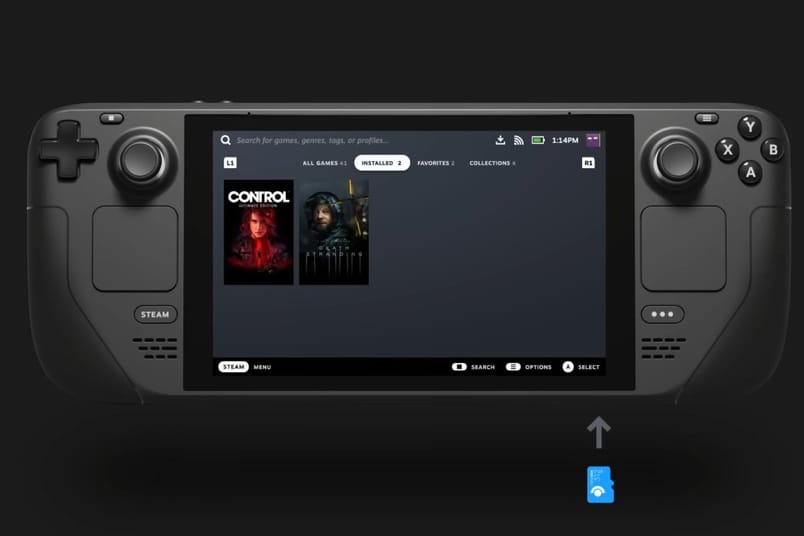
Asus ROG Ally: The First Mass-Market PC Windows Handheld
After seventeen years of silence in the ultra-portable segment, Asus returned in a big way. On May 11, 2023, the company unveiled the ROG Ally, the first mass-produced handheld from a global brand running full Windows 11.
The device hit shelves on 13 June, priced at $699 for the Ryzen Z1 Extreme model (8-core Zen 4 @ 5.1 GHz, 12 CU RDNA 3) and $599 for the base Ryzen Z1. Its 7-inch Full HD IPS display (120 Hz, VRR) offers twice the pixel density of the Steam Deck, while a 9-30 W TDP range lets users choose between roughly 2.5 and 5 hours of work (depending on the game played). The Armoury Crate SE launcher hides the Windows desktop behind a console-style interface, making titles from Steam, Game Pass, and other platforms easy to run.
At launch, the Ally struggled with fan noise and limited battery life, but BIOS updates cut power draw and boosted average frame rates by 5-10 %. Reported sales nearing 500,000 units by August 2023, making it the best-selling Windows handheld of its first year, and IDC later estimated the Ally held about 30% of all PC-handheld shipments for 2023, pushing niche manufacturers into the background. Asus ROG Ally prompted Valve to release the Steam Deck OLED (2023) as a response.
Asus’s edge lies in brand trust, global retail and service, and various polished accessories from dock stations to cables. Bottom line: the ROG Ally proved that a Windows handheld can be powerful, convenient, and ready out of the box, turning the form factor from an enthusiast toy into a mainstream option.

State of PC Handheld Market in 2025
By the end of 2024, the segment had split into two ecosystems. The Steam Deck OLED with SteamOS, upgraded 7.4-inch HDR screen, and 50 Wh battery, cemented Valve’s hold on the lower price tier ($549-649, depending on the SSD size). In the Windows camp, the Asus ROG Ally faced a flurry of rivals.
- Lenovo Legion Go (October 2023) added an 8.8-inch QHD+ screen, detachable controllers, and the same Ryzen Z1 Extreme; essentially a “Switch” on Windows.
- MSI Claw A1M followed in March 2024 as the first handheld built around Intel’s Core Ultra-155H (Meteor Lake), bringing Arc Xe graphics and an on-chip NPU for more efficient upscaling and streaming.
- Meanwhile, AYA Neo, OneXPlayer, and GPD shifted to Phoenix-HS and Core Ultra chips, expanding their ranges with 7840U/8840U models and slimmer 6-inch devices.
Rising demand for handheld PCs
IDC estimates that around 6 million PC handhelds were shipped between 2022 and 2024. Demand has leveled off but remains above pre-pandemic forecasts. To keep the momentum, Microsoft announced ROG Xbox Ally and the upgraded Ally X, both sporting an Xbox-centric interface, impulse triggers, and larger batteries. Launch is slated for Holiday 2025.
Competition now unfolds on these main parameters:
- Screen: 120-144 Hz HDR panels with VRR are becoming standard.
- Battery life: at least 50, better 60-70 Wh packs and smarter hybrid APU modes.
- Software: SteamOS, Armoury Crate SE 2, Legion Space 2.5, and Xbox Full Screen UI mask Windows complexity and reduce performance-impacting bloatware behind console-like menus.
- Peripherals: swappable controllers, USB4 docks, and eGPU support turn handhelds into desktop replacements.
The handheld PC market is entering its second generation. By mid-2025, Windows handhelds had moved from tentative first attempts to full-blown competition, with major OEMs and platform holders focusing less on raw teraflops and more on ecosystem polish and playtime per charge. AMD is expanding its range of mobile chips: the Ryzen Z2 family now includes a dedicated NPU model for local AI features, an emphasis on energy efficiency, and support for VRR displays.
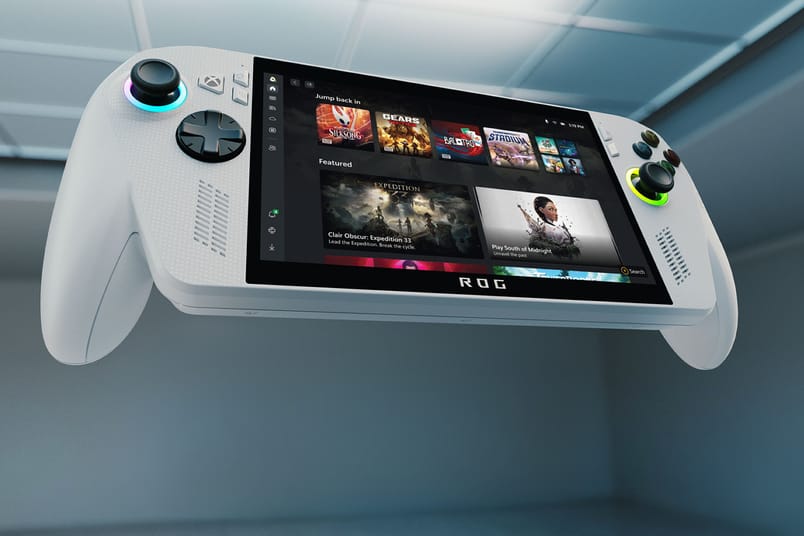
Summary: Full Circle for Windows Handhelds
The history of Windows handhelds begins with Windows CE pocket PCs and the Asus R2H experiment in 2006. After a decade of lull, GPD, OneXPlayer, and AYA Neo enthusiasts proved the viability of the idea, and Steam Deck gave it a massive boost. The return of Asus with ROG Ally has closed a historical arc: the company that laid the foundation for UMPC has brought full-featured Windows gaming into the mainstream in its pocket.
Now the market is moving faster than ever: Microsoft has officially entered the game, AMD and Intel are preparing specialized APUs, and manufacturers are competing in displays, batteries, and user interfaces. Portable PC gaming has finally ceased to be a niche: it forms a new norm, where one device replaces the console, laptop, and streaming device. Everything that was a dream in 2006 fits in the palm of your hand in 2025—and it’s only going to get better from here.



